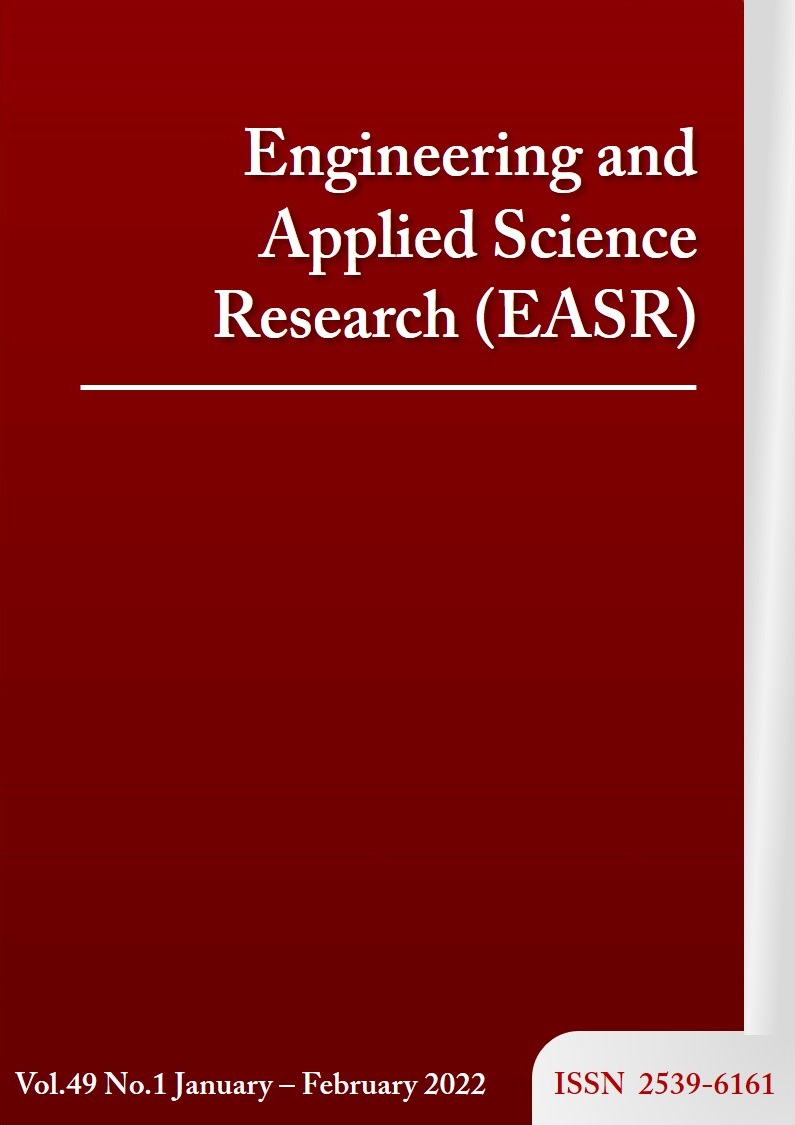Experimental study of pile set-up of driven piles in Bangkok Clay
Main Article Content
Abstract
Experimental study of pile set-up of driven piles in Bangkok Clay was conducted on seven I-shape prestressed concrete piles with their pile tips varied between 8-21 meters below ground level. The study site was selected at State Railway of Thailand (SRT) Eastern line between Hua Takhe station and Chachoengsao junction. The soil condition of the site consisted of high plasticity soft clay approximately 12 meters in thickness and the second layer is 6 meters of high plasticity medium clay, and the third layer is 4 meters of high plasticity stiff clay. Three periods of dynamic pile load test were carried out, including the end of drive (EOD), 11 days, and 32 days after pile installation to observe the pile resistance set-up behavior. After 32 days, it was found that the overall average side resistance set-up ratio is 5.4, the overall average tip resistance set-up ratio is 1.5, and the total pile resistance set-up ratio is 2.7. The increase in side resistance with time is more significant than that of tip resistance. The increase in side and tip resistances of stiff clay are smaller than those of soft and medium clays. To predict pile set-up in Bangkok Clay, the pile set-up parameter of 1.065 is recommended for Skov and Denver [1] pile resistance prediction equation.
Article Details
This work is licensed under a Creative Commons Attribution-NonCommercial-NoDerivatives 4.0 International License.
References
Skov R, Denver H. Time dependence of bearing capacity of piles. Proceedings of the 3rd International Conference on the Application of Stress-Wave Theory to Piles; 1988 May 25-27. Ottawa, Canada. Vancouver: BiTech Publishers; 1988. p. 879-88.
Ratananikom W, Likitlersuang S, Yimsiri S. An investigation of anisotropic elastic parameters of Bangkok Clay from vertical and horizontal cut specimens. Geomech Geoeng. 2013;8(1):15-27.
Ratananikom W, Yimsiri S, Likitlersuang S. Undrained shear strength of very soft to medium stiff Bangkok Clay from various laboratory tests. Geotech Eng. 2015;46(1):64-75.
Yimsiri S, Ratananikom W, Fukuda F, Likitlersuang S. Undrained strength-deformation characteristics of Bangkok Clay under general stress condition. Geomech Eng. 2013;5(5):419-45.
Haque MN, Abu-Farsakh M. Estimation of pile setup and incorporation of resistance factor in load resistance factor design framework. J Geotech Geoenviron Eng. 2018;144(11).
Komurka VE, Wagner AB, Edil TB. Estimating soil/pile set-up. Final report. Wisconsin: the Wisconsin Department of Transportation; 2003.
Ng KW, Roling M, AbdelSalam SS, Suleiman MT, Sritharan S. Pile setup in cohesive soil. I: experimental investigation. J Geotech Geoenviron Eng. 2013;139(2):199-209.
Hosseini MA, Rayhani M. Evolution of pile shaft capacity over time in marine soils. Int J Geo Eng. 2017;8(12):1-15.
Haque M, Abu-Farsakh M, Tsai C. Field investigation to evaluate the effects of pile installation sequence on pile setup behavior for instrumented test piles. Geotech Test J. 2016;39(5):769-85.
Kuntiwattanakul P. Pile set-up in Bangkok subsoil. Proceedings of the 2nd RMUTR Conference; 2017 Jun 20-21; Nakorn Pathom, Thailand. Nakorn Pathom: Rajamangala University of Technology Rattanakosin; 2017. p. 32-9. (In Thai)
Abu-Farsakh M, Haque MN, Tsai C. A full-scale field study for performance evaluation of axially loaded large-diameter cylinder piles with pipe piles and PSC piles. Acta Geotechnica. 2017;12(4):753-72.
Ng KW, Sritharan S. A procedure for incorporating setup into load and resistance factor design of driven piles. Acta Geotechnica. 2016;11:347-58.
Fellenius B. Discussion of “pile aging in cohesive soils” by Paul Doherty and Kenneth Gavin. J Geotech Geoenviron Eng. 2014;141(4):07014039.
Rausche F, Robinson B, Likins G. On the prediction of long term pile capacity from end-of-driving information. In: DiMaggio JA, Hussein MH, editor. Proceedings of the Current Practices and Future Trends in Deep Foundation; 2004 Jul 27-31; Los Angeles, USA. Reston: ASCE; 2004. p. 77-95.
Svinkin MR. Setup and relaxation in glacial sand-discussion. J Geotech Eng. 1996;122(4):319-21.
Long JH, Kerrigan JA, Wysockey MH. Measured time effects for axial capacity of driven piling. Transp Res Rec. 1999;1663(1):8-15.
Bowman ET, Soga K. Mechanisms of setup of displacement piles in sand: laboratory creep tests. Can Geotech J. 2005;42(5):1391-407.
American Association of State Highway and Transportation Officials (AASHTO). AASHTO LRFD Bridge design specifications. 7th ed. Washington: AASHTO; 2014.
Randolph MF, Carter JP, Wroth CP. Driven piles in clay-the effects of installation and subsequent consolidation. Geotechnique. 1979;29(4):361-93.
Bullock PJ, Schmertmann J, McVay MC, Townsend FC. Side shear setup. II: results from Florida test piles. J Geotech Geoenviron Eng. 2005;131(3):301-10.



